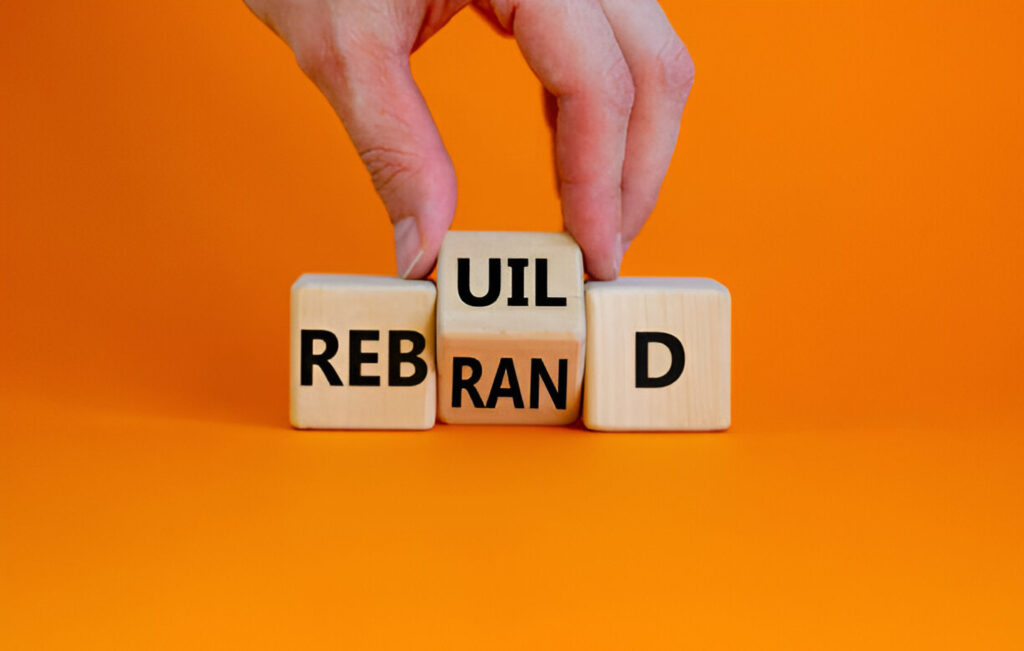Picture this: A once-beloved brand, now gathering dust on store shelves. Sound familiar? You’re not alone. In today’s fast-paced market, even industry giants can lose their shine. But here’s the kicker – a well-executed rebrand can be the difference between obsolescence and renewed prosperity.
Since 2020, a staggering 75% of global companies have embraced innovation to stay relevant. Why? Because rebranding isn’t just about a fresh coat of paint – it’s about reconnecting with your audience and boosting your bottom line. Companies that successfully rebranded saw customer approval soar and revenues jump by an impressive 33% within just two years.
Ready to breathe new life into your brand? Let’s explore how some of the biggest names in business pulled off game-changing makeovers.
After reading this article, you will learn:
- What brand revamp is,
- Which reasons lead to making such a weighty decision,
- Key points that will not only change but also improve the image of the company and
- The most successful time for changes.
In addition, you will be able to see the bright examples of companies that have successfully rebranded, understand the most remarkable moments, and identify possible developments for your business.

Overview of a Brand Revamp
Brand revamp means rebranding, which involves updating the company’s identity to improve its market position, engage with its audience and reach new heights on its way. In most cases, revamping can be caused by a variety of characteristics, with the overall objective of improving progress, producing earnings, and creating greater prospects for the organisation. For instance, the awareness of further growth of the company suggests further development, but at the same time, the current appearance and situation may only worsen the performance.
The need for rebranding can refer to varied reasons:
- competitive environment and pressure on a company’s established principles,
- company’s position and search for a new niche for trade or manufactured goods,
- inconsistency of brand history to the modern position of the company,
- change in the target audience,
- outdated marketing goals and campaigns that not delivering proper results.
From a marketing perspective, the process of revamping involves changes in various aspects such as:
- innovating the brand aim,
- developing new strategic ideas,
- changing the colour palette and design,
- working on website updates,
- adding fresh marketing materials,
- redesigning the logo,
- launching an advertisement informing about renovations.
Reasons for a Brand to Consider a Revamp
Brand image is the general impression of buyers about any company that gradually forms for them during interaction with representatives, products, services and through advertising, media, and other forms of communication. Thanks to the image, customers determine the importance and purpose of each brand based on personal interests, experience, or knowledge, which influences their subsequent decision either to continue or to stop consuming the company’s goods. The world is changing fast, so the brand image should meet modern standards and always be relevant and appropriate, reflecting the priorities of the firm and, accordingly, attracting consumers. Rebranding the image will be beneficial if the company ceases to be competitive against others and no longer attracts new customers.
The change in customer behaviour is also a sign of the necessity for rebranding. Demand for diverse types of services and goods can both grow and decline, which is the reason of important to always track changes in the statistics of purchases and variable preferences of the customers. Customer preferences may change due to various economic or social factors, technological developments, and changes in general trends. The number of new customers also affects consumption. If, for example, their age or location is different from the usual company’s customers, approaching such an audience requires innovative marketing strategies that will lead to understanding new consumers.
The reputation crisis is one of the common problems that undermine the firm’s image. This happens due to negative events or perceptions associated with the company, which destroys the trust of partners and customers. Rebranding enables the company to show its redefined intentions to improve its services and sincere desire to continue working for the good of its mission, restore mutual understanding, and customer loyalty and show its willingness to be more dependable. To sustain improvements and a long-term reputation, rebranding requires genuine changes within the company and even a rebuilding of its identity so that it works accurately. Accepting responsibility for previous mistakes and the determination to correct them further guarantees a positive market response for showing honesty.
Mergers, acquisitions, and expansions frequently demand a brand refresh that fits the newly formed corporate framework as well as a competitive advantage. Once organisations combine or absorb one more, their trademark beliefs must match to eliminate misinterpretation and provide an identical impression to stakeholders and clients. Rebranding invariably requires clearly planned actions and informing all parties concerned about the future so that the value orientations match the long-term goals of the firm.
There are common reasons why rebranding occurs in this case:
- the mix of different companies, with diverse backgrounds and cultures. Thanks to the rebranding, they will be able to complement each other, establish communication and show unity of common intentions in future work.
- the expansion to new markets on a wider scale also requires demonstrative changes, so changing brand picture and worth will be relevant.
- new opportunities and offers bring updates, so rebranding will highlight the changes in the range of services and products.
Case Studies and Process of Successful Brand Revamps
McDonald’s:
- The Challenge:
In the 2000s, lots of consumers criticised unhealthy menus at McDonald’s, which prompted the company to change its sales strategy with rebranding. The customer base continued to decrease, so McDonald’s representatives decided to rethink the brand values, bringing a more modern approach to health care.
By adding other items to its menu, such as fresh ingredients, vegetable and fruit sets, and low-calorie dishes, McDonald’s has achieved a decent result in attracting attention to its alterations and engaging new customers. The company has also updated the restaurant design and introduced modern technology, mobile applications, and fast delivery for orders by car.
- The Result:
McDonald’s competently transformed its business into an organisation that prioritises reliability along with efficiency, restoring loyalty among consumers. The brand was able not only to overcome the crisis and restore its reputation, but also profitably presented its skills of work on the company’s shortcomings.
Apple:
- The Challenge:
In the late 1990s, Apple was unpopular, had financial problems and was recognised as too outdated compared to other models of gadgets and highly competitive market technologies. To achieve success and reach a wider audience, the company had to consider a strategy of brand design and innovation renewal and positioning itself as a leader, among others.
Thanks to the leadership of Steve Jobs, the company has simplified and modernised its product line by making it unique and recognisable as well as user-friendly for customers. The elegant iMac and iPod models quickly gained popularity among famous personalities, and then among their followers.
- The Result:
Apple’s redesign resulted in a variety of revolutionary devices, specifically the iPhone, which impacted the electronic sector. After the company’s stocks soared, Apple has been perceived as innovative and even premium, which fame still does not subside.
Key Takeaway:
McDonald’s demonstrated its significance in responding to emerging health concerns and interactions with clients. Apple illustrated the way conception and functionality may transform everything in the field. Both examples show the power of replying to varying customer requirements and utilising inventiveness for marketing tactics. You can see that anticipating market changes and meeting customer preferences has led to successful rebranding and its implementation in further transformation.
Useful Findings and Key Elements of Successful Revamps
- Clear definition of the goal and planning of further stages of development of the renewed brand. Thus, the adaptation to market trends and implementation of the projected business will proceed with a minimum number of unforeseen events.
- You should always consider the expectations of your regular audience as well as the prospective new clients. The reviews show whether the new business is moving in the right direction, and the market-based ideas are a guarantee of a positive response after the change.
- Partial or full transformation of the visual component can turn over the impression of the brand in people. Using new colours, schemes, elements, typography, or logos will certainly refresh the perception. However, it is better to keep certain familiar fragments to maintain a sense of stability in regular clients.
- It is important to inform buyers about upcoming changes by providing reliable information. This way you can retain the connection and trust by sharing significant business moments with those who make it thrive.
- The support of the company’s employees is unconditional, thanks to them each part of the business performs its functions in a well-timed and high-quality manner. Understanding the rebranding prospects and adopting subsequent changes to the work environment will prepare employees and facilitate their successful adaptation.
- All channels of communication participate in the update: from social networks to packaging. The audience perceives changes easily with clear instructions and when all updates are coordinated with each other.
- Flexibility allows the firm to adapt successfully after rebranding. Developing the brand itself without losing its unique value is possible if it is aligned with future changes.
Why Companies Take the Plunge: The Driving Forces Behind Rebranding
Ever wonder why successful companies suddenly change their look? It’s not just about staying trendy. Let’s dive into the main reasons businesses opt for a brand makeover:
- Image Overhaul: Sometimes, a brand’s image becomes outdated or no longer aligns with its values. A refresh can help a company reconnect with its core identity.
- Shifting Customer Behavior: As consumer preferences evolve, brands need to adapt to stay relevant. Rebranding can help companies better resonate with their changing audience.
- Reputation Rescue: When facing a PR crisis or financial troubles, a rebrand can signal a fresh start and renewed commitment to customers.
- Corporate Shake-ups: Mergers, acquisitions, or expansions often call for a new brand identity that reflects the company’s evolved structure and goals.
The proof is in the pudding: numerous companies have used rebranding to pull themselves out of crises and reach new heights. A well-executed rebrand can:
- Set a company apart from competitors
- Strengthen market position
- Maintain and enhance customer connections
In today’s fast-paced business world, a thoughtful rebrand isn’t just a cosmetic change—it’s a strategic move that can propel a company towards greater success.
Brand renewal can seem daunting, especially when no one can guarantee the exact result. But you should not worry, because at SalesEra you can always find and ask experts who will help you in the difficult moment and explain the moments that should be taken into consideration in further business decisions. SalesEra is one of the best marketing agencies in India. You can reach us from every part of the world, so do not wait and contact us online, the first consultation is free!
Written by Karolina Kirillova







